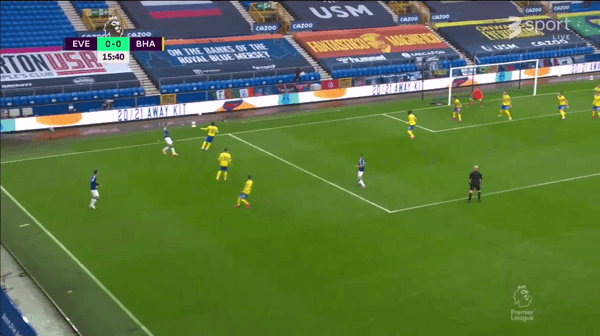Brighton are (̳𝙣̳𝙤̳𝙩̳ ̳𝙟̳𝙪̳𝙨̳𝙩 ̳) unlucky
The Seagulls have endured a strange season so far. They look good in the metrics, but not in results. So, what's going on?
Hello, you.
Welcome to the latest Marginal Pains newsletter. It’s David here, hoping you’re well.
Today we’re talking about Brighton, because, well they’ve been a tough nut to crack this season. Many have put their lack of points down to bad luck, but I explore whether it could be something more.
Before we crack on, I and Sam would just like to say thanks for the support so far. There’s been plenty of people reading the pieces and thereafter subscribing, which is nice. You can further support us by checking out some of the excellent products available through our sponsors.
Marginal Pains has partnered with LibertyShield.com - the perfect VPN companion for all your football viewing. If you’re reading this, you get 20% OFF everything using coupon code MARGINAL20.
It seems in very recent times, people have started paying attention to the fact that Brighton are a little bit strange this season.
In terms of results alone, they’re a concern. They have managed just one win across their eight Premier League matches so far and as a result, sit way down in 16th in the Premier League table. But yet, based on the underlying metrics, they look to be one of the better sides in the division.
They’re impressively 7th for shots attempted, and 1st in terms of the fewest number of shots faced. Meanwhile, in most Expected Points (xP) models this season, they rank in and around the division’s top five sides.
Although this season is still relatively young, I did see this narrative emerging back in mid-October and wrote about it within the Analytic5 newsletter. Within that piece I said:
“...In fact, based on the underlying metrics, there’s a case to say that Brighton were actually the better side in most of their matches against tough opponents so far (Chelsea, Newcastle, Man United, Everton and Crystal Palace).
They posted a higher possession average, had more shots and posted a higher Expected Goal (xG) total in four of those encounters, with only league leaders Everton bettering them in the xG department following their 4-2 defeat at Goodison Park.
As a result of the above, Brighton currently rank inside the top six based on Understat’s Expected Points (xP) table.”
We’re now a month on and very little has changed.
The above has prompted some to label them ‘unlucky’ given such a discrepancy between their underlying performance numbers and actual results. This is often the default narrative to take in these types of situations, yet, I’m of the opinion that there could well be a wider issue at play than simply bad luck.
After all, a lot of the characteristics we’re seeing in Brighton this season were also prevalent in the last campaign under Graham Potter, these being competent performances but unfavourable results. So with that in mind, let’s investigate further.
We will start by looking at Brighton’s defensive numbers given that keeper Matt Ryan has been used as the fall guy for a lot of their underperformance so far - even though in fairness to him, he has only played six of those eight league matches.
Looking at their Expected numbers, it’s easy to see why the keeper may seem to be an issue. So far, Brighton have a very impressive non-deal ball Expected Goals Against (xGA) total of just 4.81 according to Twenty3 - this is best in the division! However, they’ve conceded 14 goals.
Marginal Pains is brought to you in partnership with MANSCAPED™, the very best out there in terms of men’s below-the-waist grooming. MANSCAPED has created precision-engineered tools for your family jewels to make sure you have an unrivalled grooming experience.
As a Marginal Pains reader, you can get 20% Off and Free Shipping with the code MARGINAL20 at Manscaped.com.
If you want to support us, then support them - Your balls will thank you™
Obviously, that doesn’t look good, but don’t forget that xG is largely based on the location of a shot and therefore can be blind to other crucial aspects of a chance such as its actual quality.
We can though better capture the quality of the Seagulls’ shots faced by utilising Post-Shot xGA (PSxGA) data. For those who don’t know, PSxGA takes into consideration location, angle, pass type and body part, like traditional xG, but then it also accounts for characteristics after the shot has been taken, things such as power and trajectory.
With these added shot features, you tend to get a better indication as to whether a shot was harder or easier to save.
So far this season, Brighton have a combined non-dead ball PSxGA of 6.76. This is a fairly noticeable increase on their xGA total of 4.81, but still looks some away from their goals conceded total of 14.
However, do consider that of Brighton’s 14 goals against this season, only six have come from open play. With four arriving by way of penalties, and a further four coming as a result of a set-piece. One of those goals was also an own-goal, and another took a big deflection.
This could give further ammunition to the bad luck narrative, however, the above example was the only one of real bad luck, as the own goal against United would have been fired home by Harry Maguire had Lewis Dunk not made the unfortunate decisive touch.
Furthermore, whilst penalties against are frustrating and definitely being handed out too regularly in the modern game, as I’ve already covered, each awarded against Potter’s side was an infringement by the letter of the law and therefore Brighton can’t have too many complaints.
Anyway, when you add the rough xG values of those four penalty kicks to that PSxGA figure, you get a total of approximately 9.8. Then if you add those actual penalty goals conceded to the open play goals conceded total, you get a figure of 10 goals against.
This is hardly a standout underperformance really, is it? It’s only when we throw in those four set-piece goals do things start to look a bit abject again.
Given the low scoring nature of football, it tends to be damaging to a team’s prospects if they’re poor at defending set-pieces, yet conceding a high number of shots from dead ball situations doesn’t always reveal itself in xG models like shots from open play do.
This is because these shots are usually headers and historically, headers are harder to convert. It can vary from model to model, but as an example, the below headed goal from Dominic Calvert-Lewin in Brighton’s 4-2 defeat against Everton was awarded an xG value of just 0.05 by Wyscout.
Yet I doubt very few reading this would consider that a chance that would be converted only 5 of 100 times.
What all of the above tells us about Brighton is perhaps that, scratching beyond the surface, there is a case to be made that they’re performing largely in line with their underlying metrics from a defensive point of view, however, a potential inefficiency at defending set-pieces is proving costly.
This theory can be reaffirmed to an extent by the fact that only eight sides conceded more from set-pieces last season in the Premier League. This does therefore suggest it’s an area that needs improving by Potter.
Thankfully for Brighton, it’s an area that can be improved over time, yet, it’s less of a luck issue and more of a tactical one.
But what about the attack?
As pointed out earlier, they rank 7th for shots attempted and 9th for non-dead ball xG with a combined total of 8.59 - as per Twenty3. They’ve scored eight open play goals plus two penalties so far this season taking their overall total to ten.
There doesn’t look to be a huge level of concern about Brighton’s attack based on the fact that their non-deal ball xG and open play goal tally do look to coincide with each other so far. Furthermore, their below open play shot map does highlight a team who are creating a decent amount of chances in good locations.
Yet, there are some red flags when we delve deeper into those numbers.
Again if we utilise PSxG which better captures the quality of a strike after it’s left the attackers foot, Brighton’s combined non-dead ball PSxG totals 6.53 which is a noticeable drop on that initial xG total of 8.59. That’s a swing of around -0.25 per game and indicates rather below par finishing from the Seagulls in the attacking third.
The biggest issue seems to be a general inability to hit the target from these good shooting locations. This is captured in the below updated version of that earlier shot map which this time indicates how many of their open play shots this season have failed to hit the target.
Noticeably, just 25% of their shots this season have been on target, that’s the lowest percentage in the division.
The reason I flag this as an issue rather than attribute it to bad luck over a small sample size is that last season, Brighton had a similar such discrepancy between their non-dead ball xG and PSxG - 42.2 v 37.97.
Based on all of the above, we can see clear evidence that Brighton under Potter are certainly on the right track. They have a clear identity, players to suit and a lot of their performance indicators are good.
However, it does seem that it’s more than luck impacting their ability to turn these decent performances into more regular positive results. There evidently needs to be some fine-tuning in attack and arguably some defensive set-piece work at the back.
If they can improve in both of these areas, then don’t be surprised to see their fortunes rapidly change in a short space of time.









